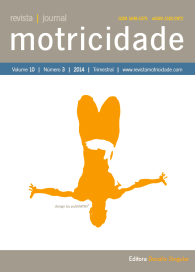Anthropometric parameters as predictors of muscle mass in elderly women
DOI:
https://doi.org/10.6063/motricidade.3680Abstract
The aims of study were to analyze the relationship between muscle mass and anthropometric parameters in elderly women and to develop a mathematical model to predict muscle mass based on anthropometric parameters. The study included 63 elderly women (71.4 ± 4.4 years). Body weight, height, arm, waist, hip and calf circumferences were measured. Muscle mass was estimated using a densitometry. The muscle mass index was calculated using the equation (muscle mass index = muscle mass [kg] / height [m]²). A significant correlation was found between muscle mass and body weight (r = 0.782), arm (r=0.688), waist (r=0.467), hip (r=0.629) and calf circumferences (r=0.592) with p<0.05 for all. Regression analysis indicated that body mass and calf circumference were independent predictors of muscle mass (r=0.81, r²=0.65, F=55.7). The prediction model obtained was muscle mass (kg)=-0.543+(0.162*body mass)+(0.151*calf circumference). No differences were observed between the amount of muscle mass and muscle mass index estimated by densitometry and by equation (p>0.05). The results of this study indicated that body mass, body mass index, arm, waist, hip and calf circumferences are related to muscle mass elderly women. The muscle mass can be adequately predicted based on data from body mass and calf circumference.
Downloads
Published
Issue
Section
License
The authors of submitted manuscripts must transfer the full copyright to Journal Motricidade / Sílabas Didáticas Editions. Granting copyright permission allows the publication and dissemination of the article in printed or electronic formats, and copyrights start at the moment the manuscript is accepted for publication. It also allows Journal Motricidade to use and commercialise the article in terms of licensing, lending or selling its content to indexation/abstracts databases and other entities.
According to the terms of the Creative Commons licence, authors may reproduce a reasonable number of copies for personal or professional purposes, but without any economic gain. SHERPA/RoMEO allows authors to post a final digital copy (post-printing version) of the article on their websites or on their institutions' scientific repository.


